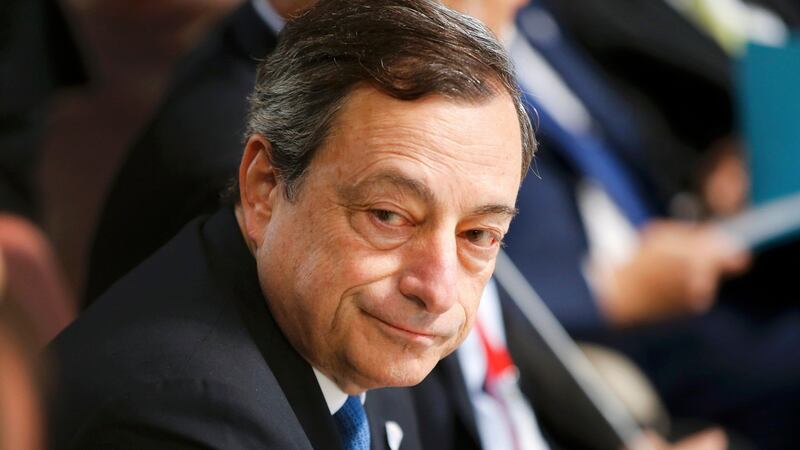Bond investors will have to get used to volatility, ECB chief Mario Draghi warned last week.
No one seems to have told equity investors, with stocks largely shrugging off wild bond market gyrations.
Ten-year German yields have soared since bottoming at 0.05 per cent in April, almost hitting 1 per cent last week after their biggest one-day rise in almost three years. US bond yields have also spiked, hitting seven-month highs.

However, stocks have been relatively calm, resulting in the ratio of bond volatility to equity volatility hitting its highest level since 2008.
Bulls aren’t bothered by the divergence. Rising interest rates indicates an improving global economy, they say, and that is good for stocks.
However, there may well be a spillover from the bond market bloodletting. "If we have a violent adjustment in rates and rates volatility and credit spreads," Deutsche Bank cautions, "then it is difficult to see how equities can perform well in that environment."
The bond market has a reputation for being shrewder than the stock market.
When the two disagree, it’s often said, trust the bond market.
If so, equity volatility may be about to increase.
Merger activity hits high
Mergers and acquisitions (M&A) are back in vogue. March was one of the strongest months for M&A activity in a decade, while May’s figures were the highest since April 2007 – months before markets topped out. Should investors be worried?
Certainly, acquisitions frenzies are associated with overvalued markets, often peaking before market declines.
However, recent M&A activity is different to past episodes.
Unlike previous merger waves, Charles Schwab analysts note, no one "hot" sector is dominant.
Secondly, the obvious warning sign – companies primarily using their own stock to buy firms – is absent. According to Schwab, more than half of deals done in Europe over the last year have been all-cash affairs.
Increased M&A activity seems logical, given rock-bottom rates and huge company cash piles, rather than being indicative of bullish fervour.
Still, the question of bond market volatility again arises. Low rates have boosted M&A activity and stock buybacks, thereby supporting equities.
Accordingly, it’s hard to see how equities would be unaffected by continued bond market turbulence.
Margin debt still a non-issue
Run for the hills! US margin debt – money borrowed to buy stocks – has hit fresh all-time highs.
It now exceeds $507 billion, compared to just $182 billion when the bull market began in March 2009, indicating speculative excess.
At least, that’s what bears are saying. Thing is, they’ve been saying it since 2011. The argument was tosh then, and it’s tosh now.
Remember, some investors will always buy stocks on margin; accordingly, as stock prices rise, so will margin debt figures.
Can rising margin debt indicate excess?
Yes. In bubbly China, it's risen fivefold over the last year. US margin debt soared 78 per cent in the year leading up to the market top in 2000.
A similar rise occurred prior to 2007’s market peak. In all those market cycles, margin debt levels outpaced equity gains.
Despite years of low interest rates, that has not happened during the current bull market; since 2009, margin debt as a percentage of stock market capitalisation has barely budged. The number of investors borrowing money to buy stocks is broadly unchanged.
Fifteen months ago, this column dismissed rising margin debt as a “non-issue”. That remains the case today.
Is Europe now too expensive?
European equities have soared in 2015; are they overpriced?
The Euro Stoxx 600 trades on 16.2 times estimated earnings, Goldman Sachs notes, well above the long-term average (12.8). Only during the 1990s tech bubble were valuations higher for any sustained length of time, Goldman cautioned.
However, Goldman remains bullish, mainly because Europe is now playing “earnings catch-up”. Unlike the US, there has been no earnings growth in Europe in recent years, but double-digit growth is finally “over the horizon”.
A sceptic might not be surprised that Goldman and Citigroup, which suggests European stocks can gain another 40 per cent by the end of 2016, are bullish. Aren't analysts invariably bullish?
Yes, but a decent European earnings rebound – late last year, the gulf between European and US earnings hit record levels – is overdue.
Additionally, Europe’s cyclically adjusted price-earnings ratio (Cape) is in line with historical averages.
Europe is no longer cheap, but it’s nowhere nearly as pricey as it might seem.
Create your own narrative
Would you like to become a financial pundit, one of those “experts” who can trot out trot out simplistic explanations for every single market move? If so, then check out stockcats.com.
“Create your own stock market narrative,” the homepage reads. “Just use the drop-down boxes below to easily rationalise why the market moved today!”
Try it out – the clichéd narratives are scarily familiar.










